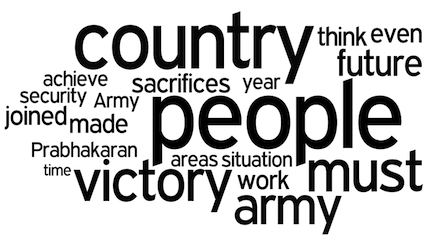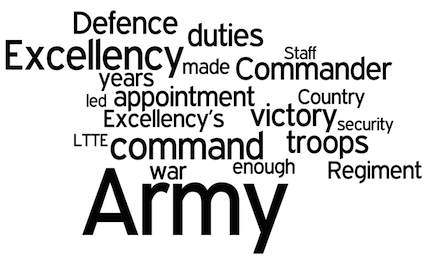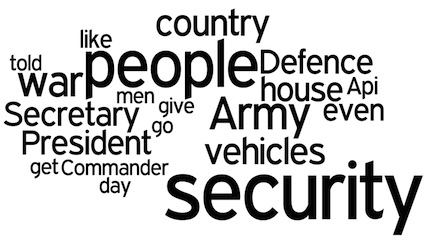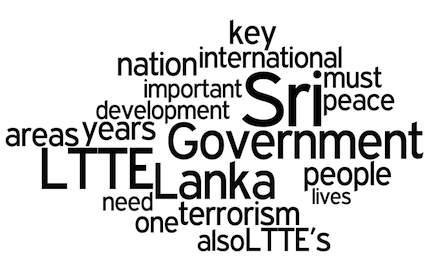Now officially a Presidential aspirant, erstwhile Army Commander Sarath Fonseka has, since late October 2009 made a number of verbal and written submissions regarding his candidacy and political life after retirement. In October 2009 he made a speech at a Buddhist Temple in Washington DC. On the 12th November, he handed in his resignation addressed to the President. On 27th November, when it was an open secret that he would contest the Presidential elections, he gave an in-depth interview to the Daily Mirror newspaper.
For the first time, the following visualizations of Fonseka’s key submissions to date, using the web based Wordle, reveal the most frequently used words in each of them.
Visualisations such as this obviously have their drawbacks for serious semantic analysis. For example, the former General’s interview with the Daily Mirror was a clear and controversial break with the Executive’s avowed belief that post-war, there are no longer any minorities or majorities in Sri Lanka. On the other hand, these visualisations provide interesting insights into Fonseka’s vision and the possible thrust of his imminent Presidential campaign by flagging key words, phrases and ideas.

Speech made in Washington DC
One can clearly see the former General’s political ambitions in the speech made in Washington DC through the significant emphasis on the country and its people. At the same time, Fonseka also stresses the victory against the LTTE, the sacrifices of the Army, and things that need to be done to secure a better future.

Letter of resignation
Unsurprisingly, the letter of resignation strikes a completely different chord. Here, the predominant emphasis is on the Army and his command of it. Addressed to the President, he repeatedly calls the Executive’s attention to his actions during war leading to victory. There is no little or no emphasis on country, its people or its future as was the case in Washington DC.

Daily Mirror interview
The interview with the Daily Mirror harks back to the expression and emphases in Washington DC. Here again we find many references to country, its people, the Army and war. On the other hand, the emphasis on security, house, vehicles, the Secretary of Defence and the President reveal significant grievances against the Rajapakse administration.
Given the (growing) tensions between Fonseka and the Rajapakse administration, the following is an interesting visualisation of Gotabaya Rajapaksa’s Olcott Oration at Ananda College on 4th December.

Rajapakse’s emphasis is clearly, and quite understandably Statist – choosing to highlight the political leadership and role of Government in the victory against the LTTE. For the Defence Secretary, the LTTE is still very much a topic of conversation. Unlike Fonseka, who concentrates on personal grievances and domestic issues in all of the examples above, Rajapakse in this speech flags peace, development, international aspects as well as domestic issues.
The visualisations are also interesting for what Fonseka and Rajapakse omit stressing as much as victory, Army, war and the LTTE. Inter alia, there is comparatively little or no significance afforded to democracy, human rights or the dire humanitarian conditions in Menik Farm in particular. Neither Fonseka nor Rajapakse stress the issue of war crimes or crimes against humanity, though rather  interestingly, Fonseka on the BBC recently seemed far less hostile to discussing this issue than the incumbent Executive.
Groundviews will continue to visualise key speeches of the Presidential candidates over the course of the campaign, as they provide a novel way to easily grasp key ideas and messages in campaign speeches, promises and individual manifestos.
